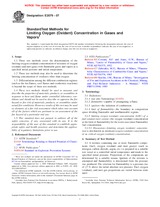Potřebujeme váš souhlas k využití jednotlivých dat, aby se vám mimo jiné mohly ukazovat informace týkající se vašich zájmů. Souhlas udělíte kliknutím na tlačítko „OK“.
ASTM E2079-07
Standard Test Methods for Limiting Oxygen (Oxidant) Concentration in Gases and Vapors
Automaticky přeložený název:
Standardní zkušební metody pro omezení kyslík ( okysličovadlo ) Koncentrace v plynech a par
NORMA vydána dne 1.1.2007
Informace o normě:
Označení normy: ASTM E2079-07
Poznámka: NEPLATNÁ
Datum vydání normy: 1.1.2007
Kód zboží: NS-44219
Počet stran: 10
Přibližná hmotnost: 30 g (0.07 liber)
Země: Americká technická norma
Kategorie: Technické normy ASTM
Anotace textu normy ASTM E2079-07 :
Keywords:
ICS Number Code 75.160.30 (Gaseous fuels)
Doplňující informace
| Significance and Use | ||||||||||
|
Knowledge of the limiting oxygen (oxidant) concentration is needed for safe operation of some chemical processes. This information may be needed in order to start up or operate a reactor while avoiding the creation of flammable gas compositions therein, or to store or ship materials safely. NFPA 69 provides guidance for the practical use of LOC data, including the appropriate safety margin to use. Examples of LOC data applications can be found in references (2, 3, 4). Note 2—The LOC values reported in references (5, 6, and 7), and relied upon by a number of modern safety standards (such as NFPA 69 and NFPA 86) were obtained mostly in a 5-cm diameter flammability tube. This diameter may be too small to mitigate the flame quenching influence impeding accurate determination of the LOC of most fuels. The 4-L minimum volume specified in Section 7 would correspond to a diameter of at least 20 cm. As a result, some LOC values determined using this standard are approximately 1.5 vol.% lower than the previous values measured in the flammability tube, and are more appropriate for use in fire and explosion hazard assessment studies. Much of the previous literature LOC data (5, 6, 7) were measured in the flammability tube. |
||||||||||
| 1. Scope | ||||||||||
|
1.1 These test methods cover the determination of the limiting oxygen (oxidant) concentration of mixtures of oxygen (oxidant) and inert gases with flammable gases and vapors at a specified initial pressure and initial temperature. 1.2 These test methods may also be used to determine the limiting concentration of oxidizers other than oxygen. 1.3 Differentiation among the different combustion regimes (such as the hot flames, cool flames and exothermic reactions) is beyond the scope of these test methods. 1.4 These test methods should be used to measure and describe the properties of materials, products, or assemblies in response to heat and flame under controlled laboratory conditions and should not be used to describe or appraise the fire hazard or fire risk of materials, products, or assemblies under actual fire conditions. However, results of this test may be used as elements of a fire risk assessment which takes into account all of the factors which are pertinent to an assessment of the fire hazard of a particular end use. This standard does not purport to address all of the safety concerns, if any, associated with its use. It is the responsibility of the user of this standard to establish appropriate safety and health practices and determine the applicability of regulatory limitations prior to use. |
||||||||||
| 2. Referenced Documents | ||||||||||
|
Doporučujeme:
Aktualizace zákonů
Chcete mít jistotu o platnosti užívaných předpisů?
Nabízíme Vám řešení, abyste mohli používat stále platné (aktuální) legislativní předpisy.
Chcete vědět více informací? Podívejte se na tuto stránku.




 Cookies
Cookies
